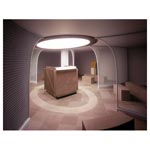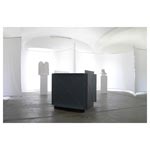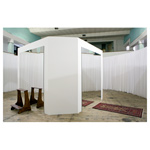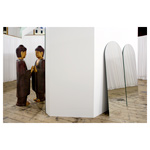In the summer of 2000 a permanent installation of Pistoletto’s was unveiled at the Paoli-Calmettes cancer hospital in Marseille: a space divided into five sections, separated by a grating, laid out around a central area like the petals of a flower. Four of the sections host symbols of the religion to which they are dedicated (Judaism, Christianity, Buddhism, Islam), chosen by representatives of the respective local religious communities. The fifth, devoted to other confessions and to nonbelievers, contains a number of books. The central area houses the Cubic Meter of Infinity [Metrocubo d'infinito], one of Pistoletto’s works from 1966, consisting of a cube formed by six mirrors with their reflecting surface turned inward.
“The first fire around which human beings gathered was the center of society. The first stone that gathered people around itself was at once a sculpture and an altar. The first person who placed that stone at the center of the group and made graffiti on the wall of the cave was an artist and a prophet. This space of meditation aspires to be a prophetic place of art today.”
(M. Pistoletto, publication for the unveiling of the work [Marseille: Bureau des Compétences, 2000]).
In 2009 Pistoletto created another installation with which he tackled the theme of spirituality and the monotheistic religions. It was The Time of Judgment [Il tempo del giudizio] (2009), a temple that brought the main monotheistic religions together in a single place: Christianity, Islam, Buddhism and Judaism. Each religion was represented by a symbolic element located in front of a mirror: a kneeling-stool, a prayer rug and a statue of the Buddha. The odd one out was Judaism, represented instead by two mirrors in the form of the Tablets of the Law. The title of this work recalls two of the artist’s earlier actions. One carried out in 1968, The Trumpets of Judgment [Le trombe del giudizio], in which Michelangelo and Maria Pistoletto had themselves photographed in the act of blowing two giant trumpets in the courtyard of the artist’s studio. The second was on the occasion of the exhibition “Art Takes on Religion” in 1978, at which he had carried out and discussed with the public several actions, including writing on the wall “Does God exist? Yes, here I am!” [“C'è Dio? Sì, ci sono”] and “It is the hour of judgment.” [“È l'ora del giudizio.”].
The Time of Judgment would be presented on various occasions, including the particularly significant exhibition “Michelangelo Pistoletto: The Mirror of Judgement” at the Serpentine Gallery in London in 2011. The reader is referred to its catalogue, containing interviews with the artist by G. Celant, J. Peyton-Jones and H. Ulrich Obrist, for further information.



